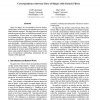Free Online Productivity Tools
i2Speak
i2Symbol
i2OCR
iTex2Img
iWeb2Print
iWeb2Shot
i2Type
iPdf2Split
iPdf2Merge
i2Bopomofo
i2Arabic
i2Style
i2Image
i2PDF
iLatex2Rtf
Sci2ools
CVPR
2008
IEEE
2008
IEEE
Correspondences between parts of shapes with particle filters
Given two shapes, the correspondence between distinct visual features is the basis for most alignment processes and shape similarity measures. This paper presents an approach introducing particle filters to establish perceptually correct correspondences between point sets representing shapes. Local shape feature descriptors are used to establish correspondence probabilities. The global correspondence structure is calculated using additional constraints based on domain knowledge. Domain knowledge is characterized as prior distributions expressing hypotheses about the global relationships between shapes. These hypotheses are generated during the iterative particle filtering process. Experiments using standard alignment techniques, based on the given correspondence relationships, demonstrate the advantages of this approach.
Approach Introducing Particle | Computer Vision | Correspondence Probabilities | Correspondence Relationships | CVPR 2008 | Distributions Expressing Hypotheses | Global Correspondence Structure |
| Added | 12 Oct 2009 |
| Updated | 12 Oct 2009 |
| Type | Conference |
| Year | 2008 |
| Where | CVPR |
| Authors | Rolf Lakämper, Marc Sobel |
Comments (0)

